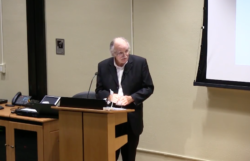Donald J. Trump as a “Morbid Symptom”
The great Italian revolutionary, Antonio Gramsci,1 when struggling to understand the rise to power of Benito Mussolini, once wrote this of Italy’s interwar crisis: that it “consists precisely in the fact that the old order is dying and the new cannot be born; in this interregnum, a great variety of morbid symptoms appear.”2 For Gramsci, the bombastic and narcissistic Mussolini was one such morbid symptom; and it is tempting – given the obvious parallels that could be drawn – to understand Donald J. Trump as his modern-day equivalent. Indeed, that parallel has been drawn,3 and drawing it can be a source of both comfort and enlightenment. But if full comfort and enlightenment are what we really seek, there is much to be gained by focusing instead on the first half of that quotation rather than on the second.
For if Gramsci was right, you get a Mussolini, or a Donald J. Trump, or for that matter the UK’s Nigel Farage, only in the gaps between broad periods of economic stability and social order; and the fact that we now have a president like Donald J. Trump is yet more evidence that – around him and us – an old order is dying and a new one cannot yet be born. If Gramsci was right, understanding the present in this manner, as an interregnum, is in that sense potentially both enlightening and comforting. It is enlightening, in that it underscores the impossibility of finding a new order by relenting pursing the old, in the manner of the Republican Party here and the Conservatives in London; and it is comforting, in that creating that new order gives an overwhelming purpose to the politics of those most opposed to those conservatives – namely the Democrats and the British Labour Party.
I
The “old order” – the one that “is dying” – is the neoliberal one called into existence in the United States by Ronald Reagan and in the United Kingdom by Margaret Thatcher. It was an “order” based on the deregulation of business, the curtailment of welfare spending, and the generation of economic growth through the weakening of labor movements and the easing of taxation on the rich. In that “order,” the steady pursuit of trickle-down economics left wages stagnant for the mass and generality of workers for an entire generation, obliging working families to maintain or increase their standard of life only by extending the length of the working day, by sending every available member of the family out to paid work, and by taking on higher and higher levels of personal debt. It was that debt-based order that came crashing down in spectacular fashion in September 2008; and which conservative forces on both sides of the Atlantic have been trying to revive ever since by pressing for yet more of the same – more austerity, more tax cuts for the rich, and more deregulation. The Trump budget, and the looming fight over the debt ceiling here in the United States, indicate very clearly that the old order, though dying, is not yet dead. That Trump budget also indicates that the adverse social consequences of now nearly four decades of neoliberalism are poised to become even worse.
That “old order,” of course, was itself once “new” – a reaction in the 1980s to the failure of the New Deal, Keynesian-based order that Democrats in the US, and the Labour Party in the UK, had created in the 1940s: a social compact built on linking wages to productivity that had generated rises in both for a quarter century before running into the buffer of stagflation in the 1970s. Like the 2010s, the 1970s as a decade were full of “morbid symptoms;” but unlike the 2010s, the 1970s were a decade of crisis not for conservatives – they had never bought into the New Deal – but for progressives in both the US and the UK who most definitely had. The Center-Left “owned” the New Deal settlement, just as now the Center-Right “owns” the neoliberal one. The 1970s collapse of the New Deal settlement gave the Center-Right its chance to build a new order, more empathetic to its values and interests. The collapse of their neo-liberal order gives contemporary progressives their chance to do the same. The question therefore becomes: will that chance be taken?
II
It could be. I hope it will be; but it will be only if several things occur.
- The first is that key players – in the Democratic Party here, and their equivalents in the British Labour Party – recognize this as the agenda that is now before them. The temptation – in both parties – to play safe and negative is huge, but will need to be avoided. It will not be enough to place the political focus on the morbid symptoms themselves. That vital critique will have to be supplemented by the clear articulation of a bigger thing: a coherent and more progressive way of organizing both the economy and its social rewards. What is at stake here – and the Center-Left must both realize it, and educate its supporters in that realization – is the creation of a new period of stability based on progressive values and sustained by progressive policies. Since those policies, as well as those values, will be vehemently opposed by conservative forces and their privileged backers, it is all the more vital that the Center-Left spends creative time now mapping out in detail what those policies should be, and what kind of economic and social order they will generate.
- The second is that, in the process of that mapping, both leaders and activists in the Democratic Party and the Labour Party must make a sharp break with their parties’ own recent accommodation to neoliberalism. There can be no going back to Clinton-style triangulation, or to Blairite enthusiasms for lightly-regulated financial institutions and weakened trade unionism. The biggest struggle the Center-Left currently faces is this internal one: the resistance, within its own leadership ranks, to this rupture with the past and this move towards a new progressive settlement. For too many leading figures in both parties right now, making that move involves admitting their own past errors of judgment; but that admission is vital, if center-left parties are ever going to speak with one voice as they educate their own supporters in the scale of change needed to bring the interregnum to a rapid and a progressive end.
There is no escaping the fact, however, that if these are the changes that are required in the politics of the Democratic Left, then meeting them will be enormously difficult. The problem of agency here is a huge one, and the major barrier to success that the Left faces on both sides of the Atlantic is ultimately itself! But there are small hopeful signs of progress on this front, not least away from these shores, in the growing strength and sophistication of the leadership of the Labour Party by Jeremy Corbyn and his allies.4 There is even some movement in the desired direction back here in the United States: with a slightly more radical set of policy proposals beginning to emerge at last from the Democratic Party leadership in the Senate,5 and with a raft of more progressive proposals now emerging from individual members of Congress (some well-known, some just starting out)6 and from well-established progressive legislative groups7 within the Democratic Party as a whole. But the creation of an all-embracing progressive consensus on both next steps and long-term goals is, as yet, far from complete and long overdue in both countries. For until and unless that creation happens, the danger is very real that one Donald. J. Trump presidency will be followed – not by the dawn of a new progressive era – but by a second Trump presidency, or by something worse! Donald J. Trump may not be the only morbid symptom we have yet to endure. But let us hope that he is – and let us call the Democratic Left to its epoch-making task!
First posted, with full citations, at www.davidcoates.net
The arguments developed here are explored further in David Coates (editor), Reflections on the Future of the Left,8 to be published in September in the UK by Agenda Publishing9 and in the US in November by Columbia University Press
3 http://www.newyorker.com/culture/culture-desk/a-scholar-of-fascism-sees-a-lot-thats-familiar-with-trump
4 See John Harris, “Britain is in the grip of its most turbulent political time in more than 30 years,” The Nation, July 27, 2017: available at https://www.thenation.com/article/britain-is-in-the-grip-of-its-most-turbulent-political-time-in-more-than-30-years/
5 See Chuck Schumer, “Chuck Shumer: A Better Deal for American Workers,” The New York Times, July 24, 2017: available at https://www.nytimes.com/2017/07/24/opinion/chuck-schumer-employment-democrats.html
6 Among the well-established are Bernie Sanders, Elizabeth Warren, and Sherrod Brown. Among the new-comers, Joe Kennedy III seems particularly active on progressive issues. For a fuller list, see https://cpc-grijalva.house.gov/caucus-members/
Tags: Antonio Gramsci, Donald Trump, interregnum, Jeremy Corbyn, Keynesianism, Labour Party, neoliberalism, progressives, social structures of accumulation
David Coates holds the Worrell Chair in Anglo-American Studies at Wake Forest University. He is the author of Answering Back: Liberal Responses to Conservative Arguments, New York: Continuum Books, 2010.
He writes here in a personal capacity.





